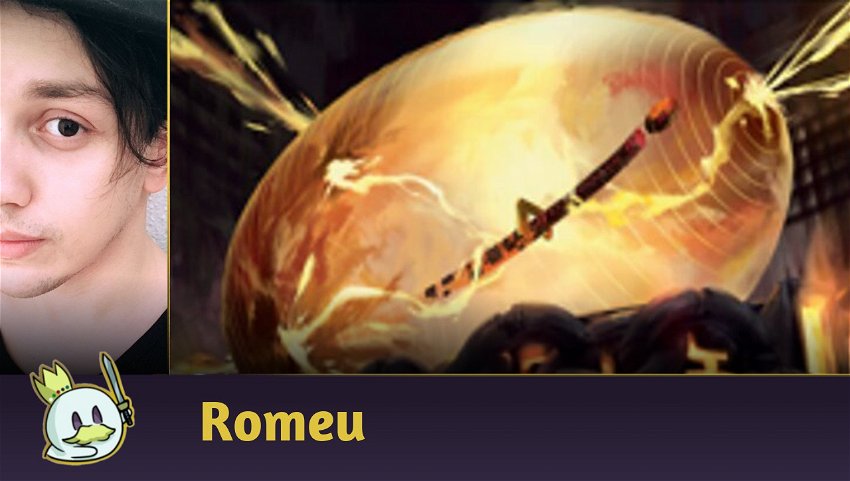Introduction
I usually prefer to wait a few weeks before doing a Pauper Metagame review after a new release or bans because there is a moment where players need to try out new ideas before we establish the best strategies and decks as per Challenges and other events.
However, Kamigawa: Neon Dynasty brought a lot of news to the format and some main inclusions are very present in the main decks, to the point that I suppose it will be interesting to evaluate how these last two weeks have unfolded and how much the new set affects Pauper.
Ad
To start, let's discuss a notorious absence from the last Challenges' Top 32:
The End of Monarchy?
Since Kamigawa: Neon Dynasty came out on online platforms, there has been a relative absence of one of the main mechanics which predominated in Pauper since Commander Legends: Monarch.

Since Monarch arrived in Pauper, its impact has been noticeable for the Metagame, with the emergence of several decks focused on obtaining and retaining the Monarch through damage prevention effects such as Prismatic Strands or board control, such as Pestilence or Crypt Rats.
But given the format's mana efficiency at the time, with spells like Daze and Gush still being legal and widely played, and archetypes like Stompy trying to play under, there was a compromise to be made when casting Palace Sentinels or Thorn of the Black Rose, as you would not always be possible to keep the Monarch so smoothly.
Over the years, Pauper changed, and its structure became focused on attrition and constant resources exchange, promoting strategies that were focused on longer games, such as Midrange, while Aggro suffered significantly from not being able to interact well with soft-locks like Tron and other fog effects, archetypes that didn't run Monarch before, like Faeries, started to play it, and Pauper essentially became a place where, in a balanced state, the Metagame was essentially Faeries x Monarch x Big Mana, and the space for fast and non-interactive strategies dwindled every month.
However, after a series of imbalances in the competitive scenario due to cards that broke the format (and I still can't fully say that the Metagame is stable today), Pauper seems to finally be making room for fast archetypes to have its space, and for some time now we have seen an interesting decrease in lists resorting to Monarch to obtain card advantage and choosing alternative which are more efficient in cost or interaction, creating changes that made the mechanic no longer mandatory for most decks.
This does not mean that the Monarch has disappeared for good, we still see archetypes like Boros Bully or Dimir Faeries doing well, but having no need to play with Palace Sentinels or Thorn of the Black Rose to keep up with the format without also having to be playing Affinity is a good sign and opens up more space for diversity.
But the real culprits of this abrupt change are specifically found in the new release:
Neon Dynasty made Pauper faster

How relevant is one mana in a game? For many, a lot, and Experimental Synthesizer is fundamental proof of that, becoming a staple for several strategies, including one well known by the community before Monarch's advent:
Kuldotha Boros and its variants reappeared in Pauper with Neon Dynasty, thanks to the inclusion of an artifact that interacts incredibly well with the proposal of cards like Glint Hawk or Kor Skyfisher, which until then seemed to have rendered obsolete by other means of obtaining card advantage.
Ad
Because it only costs one mana, Experimental Synthesizer becomes Pauper's next good value engine, and is probably the most impactful addition of the new set to the format, and its interactions with Kuldotha Rebirth or even Seeker of the Way make room for Boros variants that bet on mana efficiency and speed rather than going for the long game with Palace Sentinels and Prismatic Strands.
Boros' return is also a consequence of the rise of Mono Blue Faeries with Moon-Circuit Hacker, which offered players a reason to play with more Tempo-oriented versions, betting on the significant pressure established against the opponent by the new ninja in the first few turns, while offering its controller yet another efficient way to repurpose ETB effects.
Given the most recent results, I don't think Mono Blue Faeries has received enough to stay in the competitive scene for long, and players will soon be returning to the Dimir and Izzet variants, and while I believe the Izzet versions may seek alternative means of Card Advantage to keep up with the format, the Dimir versions are the best Monarch deck at Pauper currently because of their composition that counts on both free spells such as Snuff Out to control the board in the turn in that Thorn of the Black Rose comes into play, and by better utilizing proactive resources to establish an edge at the game.
Dimir also offers better answers to some frequent occasions in the current Metagame, such as Suffocating Fumes for dealing with tokens without necessarily giving up other utilities, or Chainer's Edict for dealing with Bogles, which has been resurfacing in Challenges, and good removals for Affinity's creatures, despite lacking more efficient answers to artifacts (which honestly doesn't seem all that relevant when the current Affinity shell is pretty much rewarded for having its artifacts destroyed).
Speaking of which...
Affinity still dictates the format
Looking at the results of the last few weeks, it is undeniable that Affinity is still the best deck in the format by a relevant margin, but less discrepant than before Atog and Prophetic Prism were banned, and Neon Dynasty haven't brought the means to combat such a threat. On the contrary:

Not only is Experimental Synthesizer the Ichor Wellspring 5–8, being a perfect target for Makeshift Munitions, Krark-Clan Shaman and Deadly Dispute (which has recently been compared to Ancestral Recall by the Twitter community), but also brought in Reckoner's Bargain to increase the consistency of the “draw 2” for Rakdos versions, essentially taking the space that formerly belonged to Grixis Affinity, as Thoughtcast has become redundant for most lists.
In a Metagame where many archetypes are trying to win the game through quick damage and small flying creatures attacking (since it's still relatively difficult to fight Affinity on the ground), casting Reckoner's Bargain sacrificing Myr Enforcer, Frogmite or Gurmag Angler not only gives its controller two new resources in their hand, it also serves as a pseudo-Time Walk, as 4 to 7 life is often more damage than a deck like Faeries can normally deal with its creatures in a single turn.
Ad
With the support of the Artifact Duals, Deadly Dispute and the countless near-parasitic interactions between its cards, Affinity is undeniably the force that moves the Metagame today and defines how lists are built and games are played, naturally forcing a change for more aggressive postures, since more reactive archetypes looking to accumulate card advantage will hardly be able to keep up in this regard because while you draw two cards per turn with Monarch, your opponent has a better board position than yours and means to draw or exile three or more cards per turn with little or no effort.
Which brings us to the question: Is Affinity still broken?
Personally, I think it's too early to make that statement, but all the evidence points to the fact that a perfect manabase added to the absurd number of draw effects puts it ahead of the rest of the format.
Does this mean that Atog's ban was wrong? Not at all.
Atog + Fling was never fair, but we accepted its existence in the format because there were several concessions of consistency, manabase, efficient answers, and other factors that made this combo-kill a fair condition for an archetype that pretty much lost to itself too many times.
Today, Affinity has a near-perfect manabase and the best draw engine the format has to offer, and it definitely doesn't need a Splinter Twin to stay competitive — even if they banned Deadly Dispute and the Duals, although on this second occasion it would likely revert to Tier 2 status or fall to Tier 3 as it also can no longer rely on Prophetic Prism and would likely become too inconsistent.
What should we do about this archetype, then? It's likely that we'll need another round of bans if its results are really out of line with the rest of the format, in which case Deadly Dispute will most likely have to leave because it offers a lot of value at a very low cost and its insanely powerful interactions with Ichor Wellspring and Experimental Synthesizer, but we still need to get past the observation phase (which, for me, lasts between a month and 45 days after a release and/or ban, being the average time that a format usually takes to adapt to sudden changes).

Another card I think is worth keeping an eye on right now is Experimental Synthesizer as, like Deadly Dispute, the new artifact does a lot for one mana, or more specifically, it's not at all wrong to say that Experimental Synthesizer is half an Arcum's Astrolabe without the upside of fixing its color requirements and getting into any deck, though it also isn't so cost-restrictive to the point of not being enabled by splashes.
But Kamigawa's greatest novelty is also enabling and bringing back many archetypes that were forgotten by players, and for now, that's reason enough to give it much more time to stay in Pauper.
Non-Interactive Decks are back
Whether due to the absence of Monarch-Based Decks, or because it's very difficult to play the fair game against Affinity, the last two weeks have seen a significant presence of non-interactive archetypes in the Top 8 this weekend.
Ad
Not only did Storm win Sunday's Pauper Challenge, it also appeared on four placements in the Top 32 of both events this weekend, and have started to show signs of a comeback even without a Storm card that wins the game directly, but counting on one that wins virtually on the next turn.

When you start your Storm count, whether Kessig Flamebreather is in play or not, a Galvanic Relay cast at the end of the process essentially guarantees that you can continue the streak the next turn without much concern, as you will normally exile 10+ cards with it, which is more than enough to guarantee a Storm loop on separate turns, and the player can still reshuffle the most important cards with Feldon's Cane to repeat the same plays for several turns in a row.
Storm's refinement to the current list took a long time and demanded the endless dedication of its enthusiasts, and it is possible that it will become one of the format's main competitors.
Bogles has also made a resurgence in the Metagame by taking advantage of the lack of Edict effects while naturally preying on Boros and can hold up well against Affinity and Storm if it can make one of its creatures gigantic fast enough to be bigger than Myr Enforcer and preferably with Armadillo Cloak.
A Stompy list won Saturday's Pauper Challenge, but given the absence of other lists in the Top 32 of recent events, I don't think we can really consider this result a fateful return, but an anomaly, as with other archetypes in other events occasionally.
I believe the trend towards the rise of non-interactive strategies could continue in the coming weeks, as long as players remain focused on attacking with small flying creatures and advancing the game quickly, or as long as Affinity remains the best deck in the format, but eventually, the Metagame will have to adapt, and that will likely bring back some midrange strategies.
Conclusion
Particularly, I like to see how Experimental Synthesizer impacts the format, and even helping some archetypes to move away from the Monarch and take advantage of more proactive strategies, while the format is clearly moving towards a scenario where speed matters as much as resources, making room for decks like Bogles and Stompy, while the lack of interaction makes Storm a much more viable strategy.
However, I'd be keeping an eye on Affinity in the coming weeks, as it remains the clear best deck, and Kamigawa's inclusions have only contributed to it becoming stronger than it already was, but it still seems too early to make a move about it and request action from the Pauper Format Panel, even though this situation is very unlikely to change in the next thirty days without direct intervention.
For now, let's enjoy the format, as it's been a long time since Pauper received some "rotation" freshness thanks to a new release.
Thanks for reading!








— 코멘트0
첫 댓글을 남겨보세요